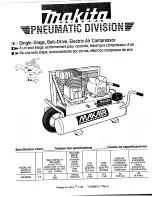
13-25-629 v03 Page 7
SECTION 1
GENERAL INFORMATION
Figure 1-1 COMPRESSOR CYCLE
COMPRESSOR
- The rotary screw compressor is a single stage, positive displacement rotary machine
using meshing helical rotors to effect compression. Both rotors are supported between high capacity anti-
friction bearings located outside the compression chamber. Roller bearings are used at the inlet end of
the rotors to carry part of the radial loads. Angular contact ball and roller bearings at the discharge end
locate each rotor axially and carry all thrust loads and the remainder of the radial loads.
COMPRESSION PRINCIPLE (
Compression is accomplished by the main and secondary
rotors synchronously meshing in a one-piece cylinder. The main rotor has five (5) helical lobes 90
apart.
The secondary rotor has six (6) matching helical grooves 72
apart to allow meshing with main rotor
lobes.
The air inlet port is located on top of the compressor cylinder near the drive shaft end. The discharge port
is near the bottom at the opposite end of the compressor cylinder.
Figure 1-1
is an inverted view to show
inlet and discharge ports
. The compression cycle begins as the rotors unmesh at the inlet port and air is
drawn into the cavity between the main rotor lobes and the secondary rotor grooves (A). When the rotors
pass the inlet port cutoff, air is trapped in the interlobe cavity and flows axially with the meshing rotors (B).
As meshing continues, more of the main rotor lobe enters the secondary rotor grove, normal volume is
reduced and pressure increases.
Oil is injected into the cylinder to remove the heat of compression and seal internal clearances. Volume
reduction and pressure increase continues until the air/oil mixture trapped in the interlobe cavity by the
rotors passes the discharge port and is released to the oil reservoir (C). Each rotor cavity follows the
same “fill-compress-discharge” cycle in rapid succession to produce a discharge air flow that is
continuous, smooth and shock free.
AIR FLOW IN THE
COMPRESSOR SYSTEM
(Figure 1-3) Air enters the air filter and passes through the
inlet unloader valve and on into the compression chamber where oil is injected into the air. After
compression, the air/oil mixture passes into the oil reservoir where most of the entrained oil is removed by
velocity change and impingement and drops back into the reservoir. The air and remaining oil then
passes through the air/oil separator. The air then passes through the minimum pressure/check valve, the
after cooler and the optional moisture separator and into the plant air lines
.
LUBRICATION, COOLING AND SEALING
- Oil is forced by air pressure from the oil reservoir through
the oil cooler, thermostatic mixing valve, and oil filter and discharge into the compressor main oil gallery.
A portion of the oil is directed through internal passages to the bearings and shaft oil seal. The balance
of the oil is injected directly into the compression chamber to remove heat of compression, seal internal
clearances and lubricate the rotors.
Summary of Contents for L4-5C
Page 27: ...13 25 629 v03 Page 27 FIGURE 4 5 WIRING DIAGRAM 380V 60 Hz 303ECA546 B Ref Drawing Page 1 of 3...
Page 28: ...13 25 629 v03 Page 28 FIGURE 4 6 WIRING DIAGRAM 380V 60 Hz 303ECA546 B Ref Drawing Page 2 of 3...
Page 29: ...13 25 629 v03 Page 29 FIGURE 4 7 WIRING DIAGRAM 380V 60 Hz 303ECA546 B Ref Drawing Page 3 of 3...
Page 30: ...13 25 629 v03 Page 30 FIGURE 4 8 WIRING DIAGRAM 575V 305ECA546 A Ref Drawing Page 1 of 3...
Page 31: ...13 25 629 v03 Page 31 FIGURE 4 9 WIRING DIAGRAM 575V 305ECA546 A Ref Drawing Page 2 of 3...
Page 32: ...13 25 629 v03 Page 32 FIGURE 4 10 WIRING DIAGRAM 575V 305ECA546 A Ref Drawing Page 3 of 3...
Page 61: ...13 25 629 v03 Page 61 Figure 9 5 Compressor Module Hardware...








































